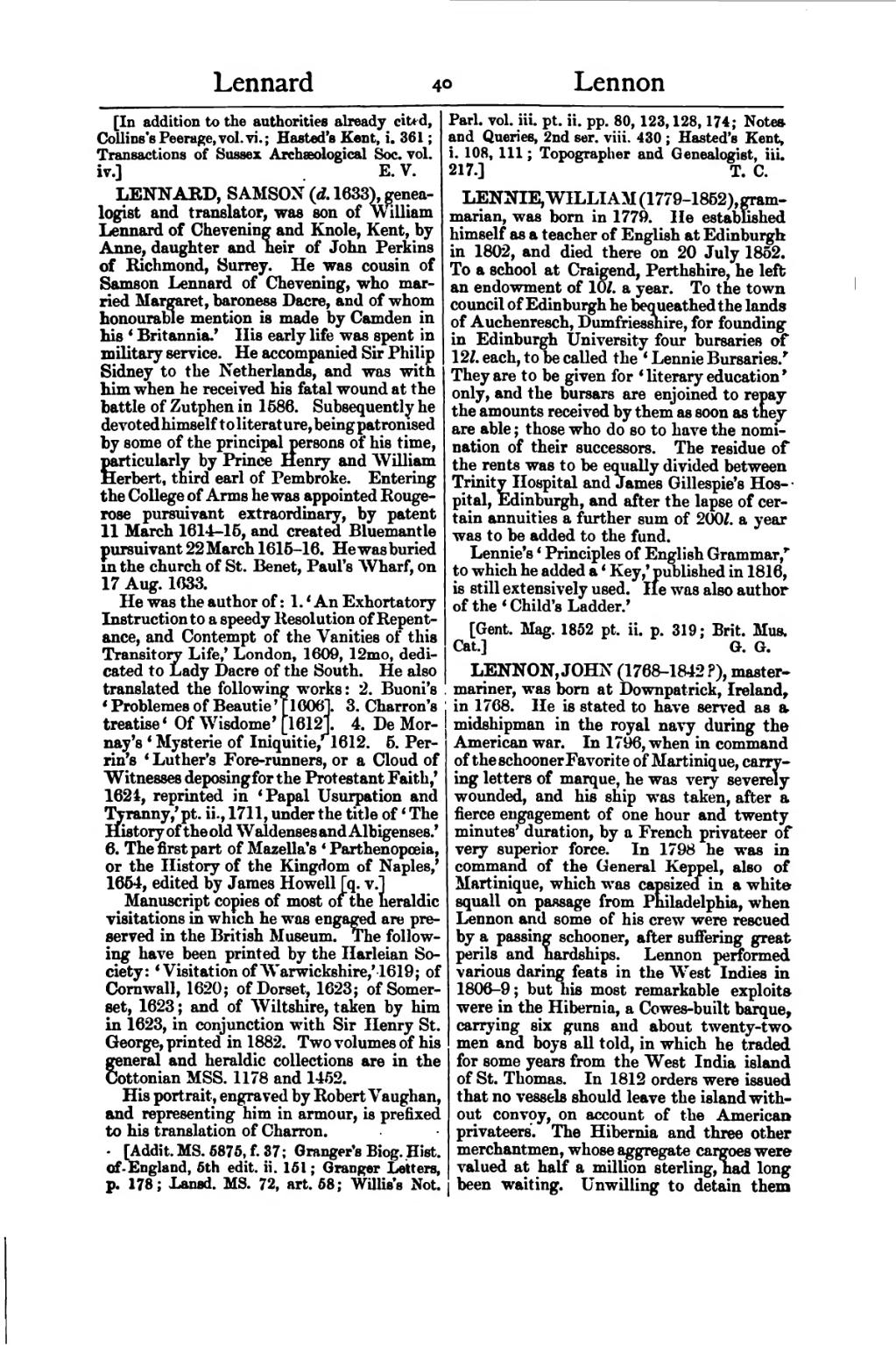[In addition to the authorities already cited, Collins's Peerage, vol. vi.; Archæological Soc. vol. iv.]
LENNARD, SAMSON (d. 1633), genealogist and translator, was son of William Lennard of Chevening and Knole, Kent, by Anne, daughter and heir of John Perkins of Richmond, Surrey. He was cousin of Samson Lennard of Chevening, who married Margaret, baroness Dacre, and of whom honourable mention is made by Camden in his 'Britannia.' His early life was spent in military service. He accompanied Sir Philip Sidney to the Netherlands, and was with him when he received his fatal wound at the battle of Zutphen in 1586. Subsequently he devoted himself to literature, being patronised by some of the principal persons of his time, particularly by Prince Henry and William Herbert, third earl of Pembroke. Entering the College of Arms he was appointed Rouge-rose pursuivant extraordinary, by patent 11 March 1614-15, and created Bluemantle pursuivant 22 March 1615-16. He was buried in the church of St. Benet, Paul's Wharf, on 17 Aug. 1633.
He was the author of:
- 'An Exhortatory Instruction to a speedy Resolution of Repentance, and Contempt of the Vanities of this Transitory Life,' London, 1609, 12mo, dedicated to Lady Dacre of the South.
He also translated the following works:
- Buoni's 'Problemes of Beautie'[1606].
- Charron's treatise 'Of treatise 'Of Wisdome' [1612].
- De Mornay's 'Mvsterie of Iniquitie, 1612.
- Perrin's 'Luther's Fore-runners, or a Cloud of Witnesses deposing for the Protestant Faith,' 1621, reprinted in 'Papal Usurpation and Tyranny,' pt. ii., 1711, under the title of 'The History of the old Waldenses and Alhigenses.'
- The first part of Mazella's 'Parthenopœia, or the History of the Kingdom of Naples,' 1654, edited by James Howell [q. v.]
Manuscript copies of most of the Heraldic visitations in which he was engaged are preserved in the British Museum. The following have been printed by the Harleian Society: 'Visitation of Warwickshire,’ 1619; of Cornwall, 1620; of Dorset, 1623; of Somerset, 1623; and of Wiltshire, taken by him in 1623, in conjunction with Sir Henry St George, printed in 1882. Two volumes of his general and heraldic collections are in the Cottonian MSS. 1178 and 1452.
His portrait, engraved by Robert Vaughan, and representing him in armour, is prefixed to his translation of Charron.
Addit. MS. 5675, f. 37; Granger's Biog. Hist. of England, 5th edi. ii. 151; Granger Letters, p.175; Lansd. MS. 72, art. 58; Willis's Not. Parl. vol. iii. pt. ii. pp. 80, 123, 128, 174; Notes and Queries, 2nd ser. viii. 430; Hasted's Kent, Kent, i. 108, 111; Topographer and Genealogist, iii. 217.]
LENNIE, WILLIAM (1779–1852), grammarian, was born in 1779. He established himself as a teacher of English at Edinburgh in 1802, and died there on 20 July 1852. To a school at Craigend, Perthshire, he left an endowment of 10l. a year. To the town council of Edinburgh he bequeathed the lands of Auchenresch, Dumfriesshire, for founding in Edinburgh University four bursaries of 12l. each, to be called the ‘Lennie Bursaries.’ They are to be given for ‘literary education’ only, and the bursars are enjoined to repay the amounts received by them as soon as they are able; those who do so to have the nomination of their successors. The residue of the rents was to be equally divided between Trinity Hospital and James Gillespie's Hospital, Edinburgh, and after the lapse of certain annuities a further sum of 200l. a year was to be added to the fund.
Lennie's ‘Principles of English Grammar,’ to which he added a ‘Key,’ published in 1816, is still extensively used. He was also author of the ‘Child's Ladder.’
[Gent. Mag. 1852 pt. ii. p. 319; Brit. Mus. Cat.]
LENNON, JOHN (1768–1842?), master-mariner, was born at Downpatrick, Ireland, in 1768. He is stated to have served as a midshipman in the royal navy during the American war. In 1796, when in command of the schooner Favorite of Martinique, carrying letters of marque, he was very severely wounded, and his ship was taken, after a fierce engagement of one hour and twenty minutes' duration, by a French privateer of very superior force. In 1798 he was in command of the General Keppel, also of Martinique, which was capsized in a white squall on passage from Philadelphia, when Lennon and some of his crew were rescued by a passing schooner, after suffering great perils and hardships. Lennon performed various daring feats in the West Indies in 1806–9; but his most remarkable exploits were in the Hibernia, a Cowes-built barque, carrying six guns and about twenty-two men and boys all told, in which he traded for some years from the West India island of St. Thomas. In 1812 orders were issued that no vessels should leave the island without convoy, on account of the American privateers. The Hibernia and three other merchantmen, whose aggregate cargoes were valued at half a million sterling, had long been waiting. Unwilling to detain them
